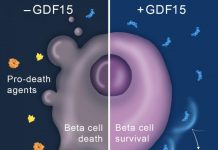July 2007 - A diagnosis of type 1 diabetes means a life sentence of medical follow-up. While treatments have become simpler and less restrictive in recent years, they are still a burden, especially for young patients.
The latest study published in the journal Nature by Dr. Constantin Polychronakos, Director of the Pediatric Endocrinology Department at the MUHC, in collaboration with Dr. Hakon Hakonarson, Director of the Centre for Applied Genomics of the Children's Hospital of Philadelphia (CHOP), provides hope that this situation will evolve in the long term toward a cure for this disease.
Using innovative high-density DNA microchip technology, which can test 550,000 genes in a single analysis, Drs. Polychronakos and Hakonarson have detected a new gene involved in type I diabetes. To date, only 4 of the genes responsible for this disease had been identified - this now makes 5.
"We believe there are approximately 15 genes involved in insulin-dependent diabetes; our study proved that high-density DNA microchips are effective and we hope to use them to identify all of these genes in the near future," explained Dr. Polychronakos, also a professor of pediatrics and human genetics at McGill University.
The causes of type I diabetes are still a relative mystery. It is estimated that approximately 50% are genetic and 50% environmental, which is why the validation of a new, extremely powerful analysis method and the identification of a new gene involved is extremely important.
Continue Reading Below ↓↓↓
The newly discovered gene goes by the elegant name "KIAA0350." While its precise role is not yet known, it is activated mainly in the immune system; this finding makes perfect sense, since type I diabetes is an autoimmune disease - the patient's immune system destroys its own insulin-producing pancreatic cells, which it mistakenly identifies as foreign bodies.
The identification of these genes will help advance research on two fronts: prevention and treatment. Prevention, as the findings will help develop more effective tests for newborns prone to developing type I diabetes. Treatment, as, according to Dr. Hakonarson, "we can now design highly specific drugs that will precisely target the effects of the defective gene." These treatments, combined with a stem cells regeneration therapy, will relieve patients of all symptoms of diabetes.
Dr. Polychronakos notes, "While this prospect is still far off, it is realistic, and this study is the first step in the right direction."
This study was funded by the Juvenile Diabetics Research Foundation (JDRF), by the CHOP, and by Genome Canada.
Source: JDRF









